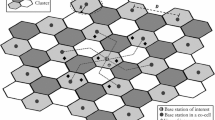Abstract
This paper presents a number of results obtained based on a CDMA–OFDM simulator developed in Matlab. The simulator has been extended to accommodate in a flexible manner to different modulation schemes, multiple access techniques, spreading codes types and lengths, convolutional codes rates, number of users and types of channels. The performances are evaluated and compared based on the Bit Error Rate (BER) as a function of the Signal to Noise Ratio (SNR) results achieved in different scenarios. In this paper are presented the results obtained by the developed simulator for two types of spreading codes—perfectly orthogonal Walsh type codes versus pseudo-orthogonal Gold type codes. The performances are evaluated in different channel environments the classical AWGN, pedestrian, vehicular and indoor ITU-R M.1225 models, for BPSK and QPSK modulations and 1/2 respectively 3/4 rate channel coding. Furthermore, since the results shown that the Gold spreading codes, QPSK modulation and 1/2 rate coding achieves the best performances in all type of channels analyzed, the authors investigate the effect of the code length and of the number of users on these results.










Similar content being viewed by others
References
Kaiser, S. (1995). OFDM–CDMA versus DS-CDMA: Performance evaluation for fading channels. In 1995 IEEE International conference on ICC’95 ’Gateway to Globalization’, IEEE communications, Seattle, USA (pp. 1722–1726).
Fazel, K. (1993). Performance of CDMA/OFDM for mobile communication system. In 2nd international conference on personal communications: Gateway to the 21st Century, conference record in universal personal communications, IEEE (pp. 975–979).
Wang, X., & Giannakis, G. B. (2011). Resource allocation for wireless multiuser OFDM networks. IEEE Transactions on Information Theory, 57(7), 4359–4372.
Bansal, G., Ziaul, H., Hossain, J., & Bhargava, V. K. (2010). Subcarrier and power adaptation for multiuser OFDM-based cognitive radio systems. In IEEE National Conference on Communications (NCC) (pp. 1–5).
Sangeetha, M., Vidhyacharan, B., & Cyriac, A. R. (2014). Performance analysis of downlink W-CDMA systems in Weibull and Lognormal fading channels using chaotic codes. Wireless Personal Communications, 74(2), 259–283.
Feuersnger, M., & Khn, V. (2001). Combating near far effects of linear MMSE multiuser detection in coded OFDM–CDMA. In Third international workshop on multi-carrier spread-spectrum and related topics, Oberpfafenhofen, Germany, section IV, September 2628 (pp. 241–248).
Zheng-min, K., Guang-xi, Z., Qiao-ling, T., & Yan-chun, L. (2010). A novel differential multiuser detection algorithm for multiuser MIMO–OFDM systems. Journal of Zhejiang University SCIENCE C, 11(10), 798–807.
Bhaskar, V., & Pai, L. S. (2013). Performance analysis of MC-CDMA systems under Nakagami Hoyt fading. Wireless Personal Communications, 69(4), 1885–1898.
Chang, A. C. (2013). Blind residual carrier frequency offset and timing offset estimation using improved minimum output variance approaches in uplink MC-CDMA systems. Wireless Personal Communications, 71(3), 2231–2246.
Chen, T.-C., & Lin, T.-T. (2013). A blind LCMV-based CFO estimation for MC-CDMA systems over multipath fading channels. Wireless Personal Communications, 72(4), 2263–2279.
El-Bakary, E. M., Hassan, E. S., Zahran, O., El-Dolil, S. A., & Abd El-Samie, F. E. (2013). Efficient image transmission with multi-carrier CDMA. Wireless Personal Communications, 69(2), 979–994.
Voicu, C., Halunga, S., & Vizireanu, D. (Oct. 2011). Performances of conventional and MMSE detectors for image transmissions. In 10th international conference on telecommunication in modern satellite cable and broadcasting services (TELSIKS), 2011, Nis, Serbia (vol. 1, pp. 76, 79, 5–8).
Xiangbin, Y., & Dazhuan, X. (2012). Performance analysis of space-time coded CDMA system over nakagami fading channels with perfect and imperfect CSI. Wireless Personal Communications, 62(3), 633–653.
Craciunescu, R., Halunga, S., Fratu, O., & Vizireanu, N. (2013). Multi user orthogonal frequency division multiple access (MU-OFDMA) performances in AWGN and fading channels. In 2013 11th international conference on telecommunication in modern satellite, cable and broadcasting services (TELSIKS) (vol. 1, pp. 229–232).
Manea, O. C., Craciunescu, R. E., Halunga, S. V., Voicu, C., & Preda, R. O. (2013). Performance evaluation of subcarrier allocation methods for OFDMA. In 21st telecommunications forum (TELFOR) (pp. 260–263).
IEEE Computer Society, IEEE Microwave Theory and Techniques Society, IEEE Standard for Air Interface for Broadband Wireless Access Systems—IEEE Std 802.16™-2012 (Revision of IEEE Std 802.16-2009).
Farhad, B., & Mahmood, E. (2012). MATLAB: a fundamental tool for scientific computing and engineering applications, Volume 2, InTech, September 26. http://www.intechopen.com/books/matlab-a-fundamental-tool-for-scientific-computing-and-engineering-applications-volume-2. Acces- sed May 2014.
Cho, Y. S., Kim, J., Yang, W. Y., & Kang, C. G. (2010). MIMO–OFDM wireless communications with Matlab. London: Wiley.
Acknowledgments
This work has been funded by UEFISCDI Romania under Grant No. 20/2012 “Scalable Radio Transceiver for Instrumental Wireless Sensor Networks”, SaRaT-IWSN, and by the Sectoral Operational Programme Human Resources Development 2007–2013 of the Ministry of European Funds through the Financial Agreement POSDRU/159/1.5/S/132397.
Author information
Authors and Affiliations
Corresponding author
Rights and permissions
About this article
Cite this article
Craciunescu, R., Manea, O., Halunga, S. et al. Considerations on CDMA–OFDM System Performances in Different Channel Environments for Different Modulation and Coding Scenarios. Wireless Pers Commun 78, 1667–1682 (2014). https://doi.org/10.1007/s11277-014-1907-8
Published:
Issue Date:
DOI: https://doi.org/10.1007/s11277-014-1907-8




